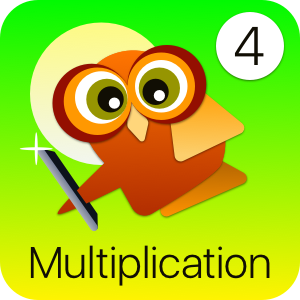
This app promotes fluency of numerical facts up to 12 to solve multiplication equations including two-step and multi-step word problems. G4M students utilize multiplication properties as strategies based on place value, arrays and area models to solve function tables, 2-digit by 2-digit and 4-digit by 1-digit equations.
Grade 4 App Includes:
- Five skill-based animated Learn Lesson videos:
- Terms & Patterns
- Particular Products
- Word Problems
- Long Multiplication
- Word Problems with Variables
- Five fun, interactive Try Modules to practice & reinforce core skills taught:
- Regrouping Module with random equations to solve
- Word Problem Module
- Function Factory Interactive Input/Output tables
- Over 100 Flash Cards with answers
- AppTutor Quick Challenge timed recollection test
- Hints Sheet for handy reference, emailing and printing
- 12 pages of targeted-skills Worksheets covering over 450 unique questions for extra practice with complete answer keys
- Comprehensive skill-based formal testing to check conceptual understanding
- Printable Certificate of Achievement upon completion in both AirPrint and email formats
Plus
- Complete full-subject app – no in-app upgrades
- Supports three named students plus a guest user
- Always available Scratch Pad for creative reasoning and problem solving
- Tracking includes independent progress status for each user
- Design fully supports the Common Core State Standards Initiative (CCSSI).
- One-click detailed audio instruction available throughout
- Intra-test wrong answer feedback to support enhanced learning potential
- Over 1,100 unique problems throughout the app
- Available on iPad, iPhone and iPod Touch
Grade 4 Multiplication Common Core State Standards addressed include:
- 4.OA.1 Interpret a multiplication equation as a comparison
- 1.1 Multiplication: Properties of multiplication
- 1.2 Multiplication: Choose numbers with a particular product
- 4.OA.2 Use multiplication to find a solution to word problems, which involve multiplicative comparison. The solving process may, for example, include applying drawings or equations containing a special symbol for the unknown number. The aim of such problems is to represent the difference between multiplicative comparison and additive comparison.
- 2.1 Multiplication: Estimate products: word problems
- 2.2 Multiplication: Multiply a 2-digit number by a 2-digit number: word problems
- 2.3 Multiplication: Multiply a 2-digit number by a larger number: word problems
- 2.4 Multiplication: Multiply numbers ending in zeroes: word problems
- 4.OA.3 Find a solution to multistep word problems using the four operations. Such problems deal with whole numbers in a statement and answer, as well as involve the interpretation of remainders. The representation of these problems must be made through equations, which contain a special symbol or letter for the unknown number or quantity. Received answer’s correctness must be assessed by means of mental computation, rounding, and other estimation strategies.
- 3.4 Mixed operations: Multi-step word problems
- 3.5 Algebra: Write variable expressions: word problems
- 3.6 Algebra: Write variable equations to represent word problems
- 4.OA.4 Figure out all possible factor pairs for a whole number between 1 and 100. When shown a one-digit number, determine whether it is a multiple of a given whole number between 1 and 100. Detect whether a provided whole number belongs to prime or composite numbers.
- 4.2 Multiplication: Choose the multiples of a given number up to 12
- 4.4 Mixed operations: Choose #’s with a particular product.
- 4.OA.5 Create a shape pattern or a generate a number that complies with a given rule. Recognize apparent pattern’s characteristics, which were not clearly specified in the rule.
- 5.1 Functions: Input/output tables with addition, subtraction, multiplication, and division
- 4.NBT.3 Use place value understanding to round multi-digit whole numbers to any place.
- 3.4 Multiplication: Estimate products
- 4.NBT.5 Apply place value and the properties of operations strategies to multiply a two-digit number by another two-digit number or a four-digit number by a one-digit number. Use area models and/or equations, rectangular arrays to represent the calculation process.
- 5.1 Multiplication: Multiply 1-digit numbers by larger numbers
- 5.2 Multiplication: Multiplication patterns over increasing place values
- 5.3 Multiplication: Properties of multiplication
- 5.4 Multiplication: Multiply a 2-digit # by a 2-digit number: complete the missing steps
- 5.5 Multiplication: Multiply a 2-digit number by a 2-digit number
- 5.6 Multiplication: Multiply numbers ending in zeroes
Download Resources:
